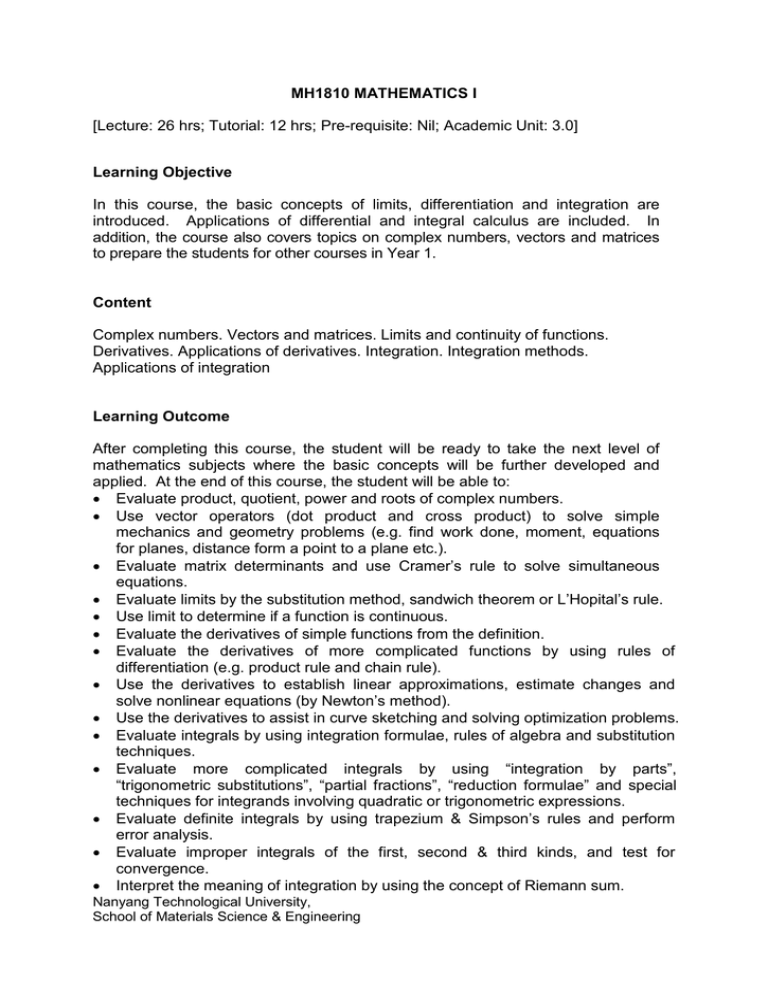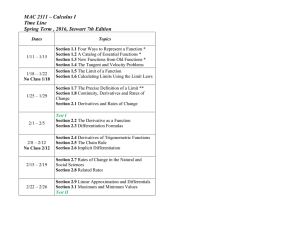
MH1810 MATHEMATICS I
[Lecture: 26 hrs; Tutorial: 12 hrs; Pre-requisite: Nil; Academic Unit: 3.0]
Learning Objective
In this course, the basic concepts of limits, differentiation and integration are
introduced. Applications of differential and integral calculus are included. In
addition, the course also covers topics on complex numbers, vectors and matrices
to prepare the students for other courses in Year 1.
Content
Complex numbers. Vectors and matrices. Limits and continuity of functions.
Derivatives. Applications of derivatives. Integration. Integration methods.
Applications of integration
Learning Outcome
After completing this course, the student will be ready to take the next level of
mathematics subjects where the basic concepts will be further developed and
applied. At the end of this course, the student will be able to:
• Evaluate product, quotient, power and roots of complex numbers.
• Use vector operators (dot product and cross product) to solve simple
mechanics and geometry problems (e.g. find work done, moment, equations
for planes, distance form a point to a plane etc.).
• Evaluate matrix determinants and use Cramer’s rule to solve simultaneous
equations.
• Evaluate limits by the substitution method, sandwich theorem or L’Hopital’s rule.
• Use limit to determine if a function is continuous.
• Evaluate the derivatives of simple functions from the definition.
• Evaluate the derivatives of more complicated functions by using rules of
differentiation (e.g. product rule and chain rule).
• Use the derivatives to establish linear approximations, estimate changes and
solve nonlinear equations (by Newton’s method).
• Use the derivatives to assist in curve sketching and solving optimization problems.
• Evaluate integrals by using integration formulae, rules of algebra and substitution
techniques.
• Evaluate more complicated integrals by using “integration by parts”,
“trigonometric substitutions”, “partial fractions”, “reduction formulae” and special
techniques for integrands involving quadratic or trigonometric expressions.
• Evaluate definite integrals by using trapezium & Simpson’s rules and perform
error analysis.
• Evaluate improper integrals of the first, second & third kinds, and test for
convergence.
• Interpret the meaning of integration by using the concept of Riemann sum.
Nanyang Technological University,
School of Materials Science & Engineering
•
•
•
•
Use integration to find areas between curves (by dividing into vertical or
horizontal strips) and volumes of solids (slicing & cylindrical shells methods).
Use integration to find volumes of solids of revolution (slicing & cylindrical shells
methods).
Use integration to find lengths of plane curves and areas of surfaces of revolution.
Use mean value theorem, fundamental theorem of calculus and Leibniz’s rule to
evaluate expressions involving differentiation and integration.
Textbooks/References
(i) Thomas, GB Jr., Weir MD, Hass J and Giordano FR, Thomas’ Calculus, 11th
edition, Pearson-Addison-Wesley, 2005
(ii) Smith RT and Minton RB, Calculus: Concepts and Connections, McGraw
Hill, 2006.
(iii) Kreysgiz E, Advanced Engineering Mathematics, 9th edition, John Wiley &
Sons, 2006.
(iv) Anton H, Calculus with Analytic Geometry, 5th edition, John Wiley & Sons,
1995.
(v) Ayres F Jr and Mendelson E, Schaum’s Outline of Theory and Problems of
Calculus, 4th edition, McGraw Hill, 2000.
Nanyang Technological University,
School of Materials Science & Engineering




